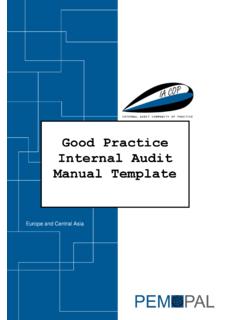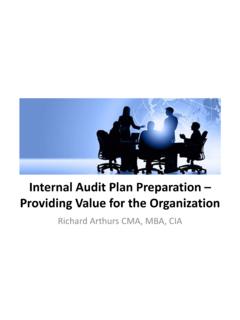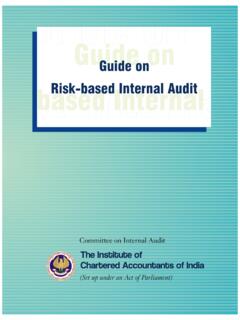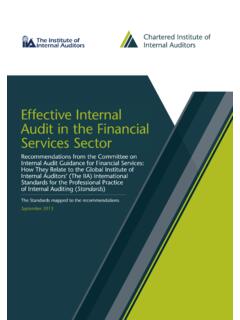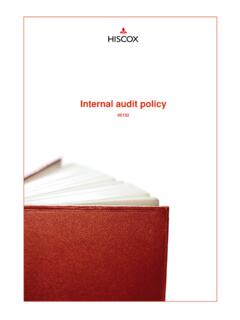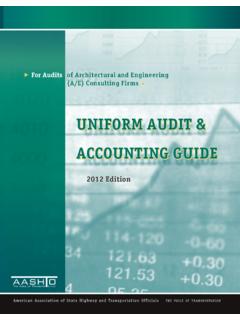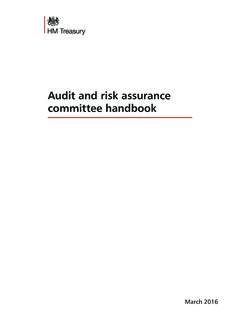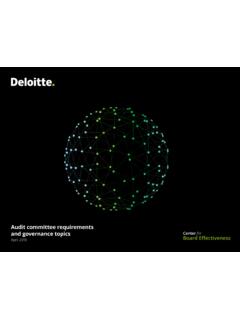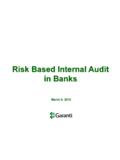Transcription of RISK ASSESSMENT IN AUDIT PLANNING
1 RISK ASSESSMENT IN AUDIT PLANNINGA guide for auditors on how best to assess risks when PLANNING AUDIT workRISK ASSESSMENT IN AUDIT PLANNINGA guide for auditors on how best to assess risks when PLANNING AUDIT workApril 20142 RISK ASSESSMENT IN AUDIT PLANNINGC ontentsPreface 3 Acknowledgement 4 Acronyms 5 Introduction 6 Background and purpose of the guide 6 Why is risk-based PLANNING important for an internal AUDIT unit 7 How to use the guide 7 Chapter 1.
2 Understanding risk-based AUDIT PLANNING 8 What are risks ? 8 Understanding the differences between risk management and risk ASSESSMENT in AUDIT PLANNING 8A conceptual framework for risk-based AUDIT PLANNING 9 Taking into account Entity Risk Management processes 10 The actions required to implement risk-based PLANNING 11 Chapter 2. Categorising the AUDIT universe for risk-based PLANNING 14 What is the AUDIT universe ? 14 The elephant approach - cutting the AUDIT universe down into small chunks 14 Seek senior managers opinions 16 Chapter 3. Identifying risks and assessing their impact and probability 17 Identifying events that may give rise to risks and opportunities across the AUDIT universe 17 Identifying risks 18 Assessing risks in terms of impact and probability 19 Criteria for assessing impact 20 Criteria for assessing probability 21 Scoring risks for impact and probability 21 Combining ASSESSMENT criteria into a risk matrix 21 Chapter 4.
3 Building risk-based strategic and annual plans 23 Identifying risk factors 23 Develop criteria to assess the importance of each risk factor 25 Consider adding a weighting to each risk factor to produce a risk index 26 Chapter 5. Writing and updating strategic and annual plans 27 Strategic plan 27 Annual AUDIT plan 28 Keeping plans up to date regular monitoring of risk 28 Annual review of the strategic plan 29 Dealing with additional requests for audits during the year 29 Annex A. Example of risk ASSESSMENT criteria for impact 30 Annex B. Example of scoring risk factors 32 Annex C. Example of IA CoP Countries 343 RISK ASSESSMENT IN AUDIT PLANNINGP refaceThis template is the product of a process of exchange of ideas and information among members of the Internal AUDIT Community of Practice (IA CoP), of the Public Expenditure Management Peer-Assisted Learning (PEM-PAL) PEM-PAL network, launched in 2006 with the help of the World Bank, is a regional body that aims to support reforms in public expenditure and financial management in twenty one countries in Central Asia and Central Eastern Europe by promoting capacity building and exchange of information.
4 IA CoP, one of the three Communities of Practice around which the network is organized, has representatives from 21 countries of the Europe and Central Asia of the IA CoP s goal is to contribute to improved Public Financial Management (PFM) systems, by supporting members to establish a modern and effective Internal AUDIT Service in their Governments that meets international and European Union (EU) standards and facilitates good governance in their public 1 IA CoP activities contribute to further this agenda by offering a guide in risk ASSESSMENT in AUDIT PLANNING , which public sector internal auditors may follow as a good practice.
5 This Risk ASSESSMENT in AUDIT PLANNING guide is the end result of a collaborative process from regional members and donor partners, which began with a workshop held in Lvov, Ukraine in October 2012. It is the hope of the PEM-PAL network and IA CoP that users of this guide, and other documents in the series, will find them informative and useful in advancing the reforms of public sector internal Source: IA CoP Balanced Scorecard4 RISK ASSESSMENT IN AUDIT PLANNINGA cknowledgementThis template was the combined effort of a number of individuals and members of the Risk ASSESSMENT Working Group of the Internal AUDIT Community of Practice (IA CoP) who shared their time and expertise to make it a , IA CoP would like to recognise the following key contributors.
6 Stanislav Bychkov, Russian Federation, Co-leader of Working Group on Risk AssessmentRuslana Rudnitska, National Academy for Finance and Economics, the NetherlandsRichard Maggs, World Bank, Consultant Manfred van Kesteren, National Academy for Finance and Economics, the NetherlandsGrigor Aramyan, Armenia, Leader of Working Group on Risk AssessmentEdit N meth, Hungary, Co-leader of Working Group on Risk ASSESSMENT , and Acting Vice-Chair of IA CoPDorotea Manolova, Bulgaria, Co-leader of Working Group on Risk AssessmentDiana Grosu-Axenti, Moldova, former Chair of the IA CoPArman Vatyan, World Bank, Coordinator of the IA CoPThe following individuals invested key efforts in establishment and initial operation of the Risk ASSESSMENT Working Group.
7 Joop Vrolijk, OECD/SIGMAA lbana Gjinopulli, Albania, former Leader of Working Group on Risk Assessment5 RISK ASSESSMENT IN AUDIT PLANNINGA cronymsCHU Central Harmonization UnitCOSO Committee of Sponsoring Organizations of the Treadway CommissionERM Enterprise Risk ManagementEU European UnionHIA Head of Internal AuditIA Internal AuditIA CoP Internal AUDIT Community of PracticeIIA Institute of Internal AuditorsIT Information TechnologyPEM-PAL Public Expenditure Management Peer Assisted LearningRAP Risk ASSESSMENT in AUDIT PlanningUN United NationsWB World Bank6 RISK ASSESSMENT IN AUDIT PLANNINGI ntroduction Background and
8 Purpose of the guide 1. The Risk ASSESSMENT in AUDIT PLANNING (RAP) guide, drafted by the PEM-PAL Internal AUDIT Community of Practice (IA CoP), emphasises the importance and the impact that an effective AUDIT strategy and AUDIT plan for the achievement of the goals, objectives and the mission of the internal AUDIT unit. PLANNING provides for a systematic approach to internal AUDIT work and requires knowledge covering a wide range of issues in pub-lic management, including risk ASSESSMENT and internal This RAP guide has been developed to: Help Internal AUDIT units to produce effective risk-based strategic and annual plans. Provide a guidance on PLANNING and risk ASSESSMENT that can be used as a set of principles by central units responsible for advising on the development on Internal AUDIT in their own countries.
9 3. The guide is fully consistent with the Institute of Internal Auditor s (IIA) International Standards for the Professional Practice of Internal Auditing on PLANNING internal AUDIT work. In particular: IIA Standard 2010 which requires The chief AUDIT executive1 must establish risk-based plans to determine the priorities of the internal AUDIT . IIA Standard which requires that The internal AUDIT activity s plan of engagements must be based on a documented risk ASSESSMENT , undertaken at least annually. The input of senior management and the board must be considered in this process . IIA Standard The chief AUDIT executive must identify and consider the expectations of senior management, the board, and other stakeholders for internal AUDIT opinions and other conclusions.
10 IIA Standard 2020, The chief AUDIT executive must communicate the internal AUDIT activity s plans and resource requirements, including significant interim changes, to senior management and the board for review and approval. The chief AUDIT executive must also communicate the impact of resource limitations. 4. These standards require the Head of Internal AUDIT (HIA)2 to develop a risk-based plan. The HIA should take into account the organisation s risk management framework, in-cluding risk appetite levels set by management for the different activities or parts of the organisation. If a risk management framework does not exist, the HIA uses his/her own judgment of risks after consideration of input from senior management and the board.
